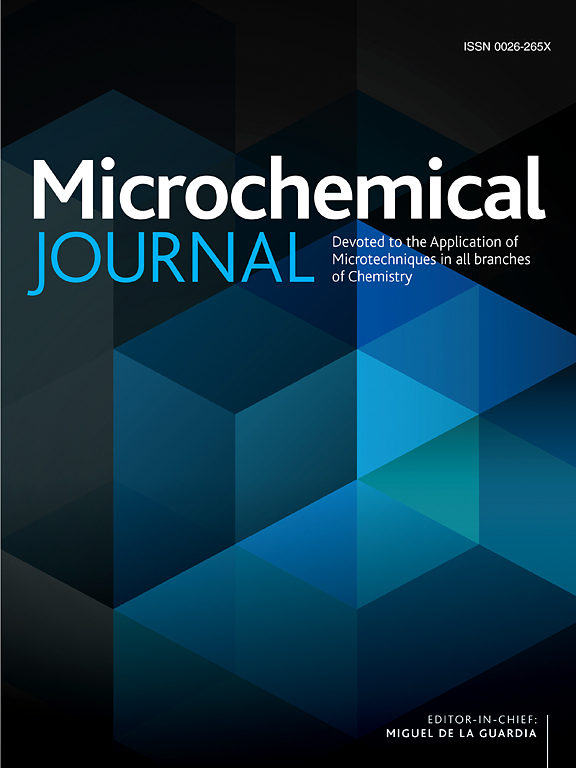Colorimetric reversibility: Aqueous phase recognition of cyanide using smart phone-based device with real sample analysis
IF 4.9
2区 化学
Q1 CHEMISTRY, ANALYTICAL
引用次数: 0
Abstract
A novel colorimetric 2-hydrazinobenzothiazole based probe (BTHP) was successfully synthesized and employed as an optical cyanide sensor. The interaction of CN− with BTHP produced a distinct color variation (dark pink color) with a red shift (96 nm) in its absorption spectra. The probe was selective, sensitive and robust towards cyanide ion sensing even in the presence of other competing ions. It could detect cyanide ion upto 0.77 µM, even lower than the limit recommended by WHO (1.9 µM). The binding stoichiometry for BTHP-CN− complex (1:1) was confirmed via Job’s plot. A binding constant of 3.19*102 M−1 was calculated in the recognition process. The cyanide ion recognition mechanism was confirmed using 1H NMR titration and DFT calculation. The probe coated filter paper test strips displayed dark pink color upon cyanide exposure. BTHP can be used reversibly for the visible detection of cyanide in liquid (real water) as well as solid phase (soil). Further, the practical applications of the developed sensor include smartphone based sensing, logic gate fabrication, molecular keypad lock and write-read-erase-read devices.

比色可逆性:使用基于智能手机的设备与真实样品分析氰化物的水相识别
成功合成了一种新型比色2-肼苯并噻唑基探针(BTHP),并将其用作光学氰化物传感器。CN−与BTHP的相互作用产生了明显的颜色变化(深粉红色),其吸收光谱红移(96 nm)。即使在存在其他竞争离子的情况下,该探针对氰化物离子也具有选择性,灵敏度和鲁棒性。检测氰化物离子最高可达0.77µM,甚至低于WHO推荐的1.9µM限值。BTHP-CN -配合物的结合化学计量(1:1)通过Job’s plot得到证实。在识别过程中计算出的结合常数为3.19*102 M−1。通过1H NMR滴定和DFT计算证实了氰化物离子识别机理。探针涂布的滤纸测试条在氰化物暴露后显示深粉红色。BTHP可以可逆地用于液体(真正的水)以及固相(土壤)中氰化物的可见检测。此外,所开发的传感器的实际应用包括基于智能手机的传感、逻辑门制造、分子键盘锁和写-读-擦-读器件。
本文章由计算机程序翻译,如有差异,请以英文原文为准。
求助全文
约1分钟内获得全文
求助全文
来源期刊

Microchemical Journal
化学-分析化学
CiteScore
8.70
自引率
8.30%
发文量
1131
审稿时长
1.9 months
期刊介绍:
The Microchemical Journal is a peer reviewed journal devoted to all aspects and phases of analytical chemistry and chemical analysis. The Microchemical Journal publishes articles which are at the forefront of modern analytical chemistry and cover innovations in the techniques to the finest possible limits. This includes fundamental aspects, instrumentation, new developments, innovative and novel methods and applications including environmental and clinical field.
Traditional classical analytical methods such as spectrophotometry and titrimetry as well as established instrumentation methods such as flame and graphite furnace atomic absorption spectrometry, gas chromatography, and modified glassy or carbon electrode electrochemical methods will be considered, provided they show significant improvements and novelty compared to the established methods.
 求助内容:
求助内容: 应助结果提醒方式:
应助结果提醒方式:


